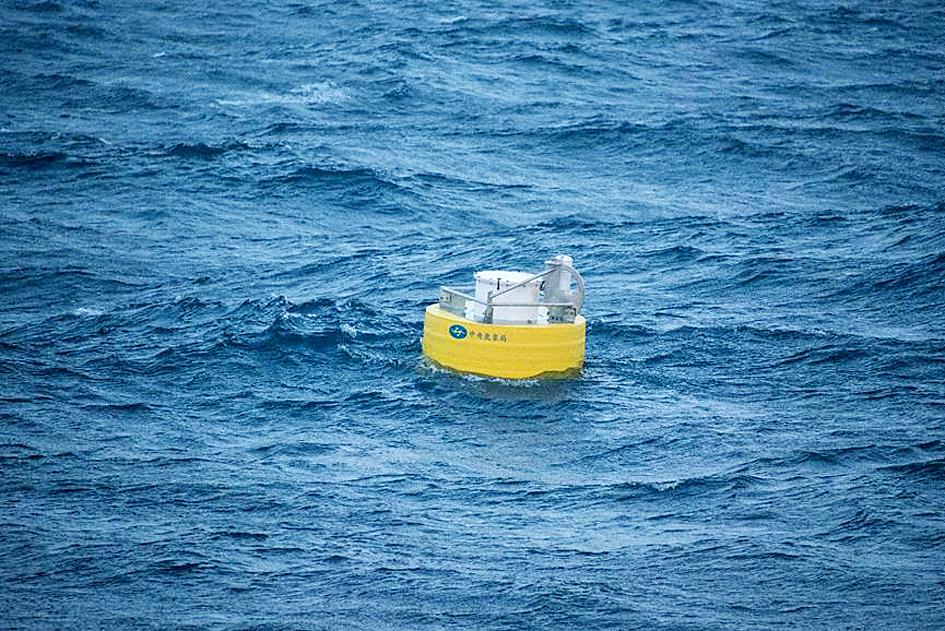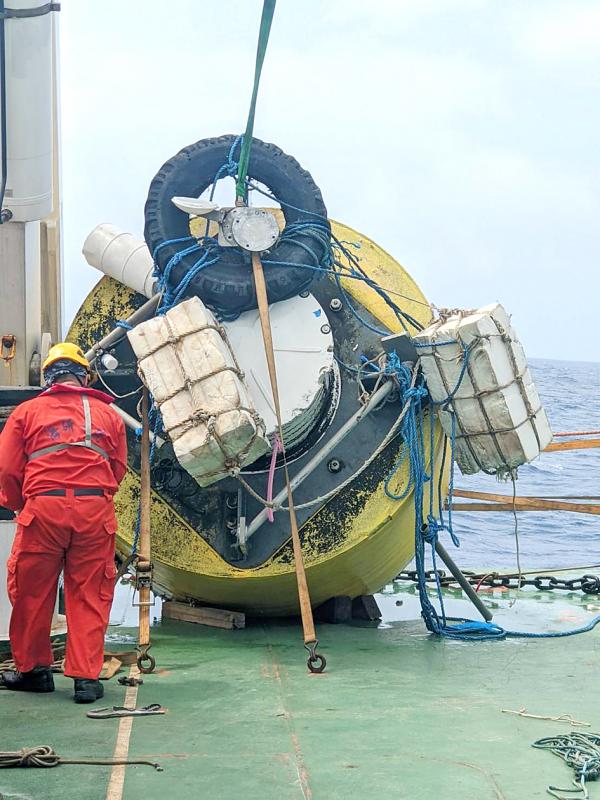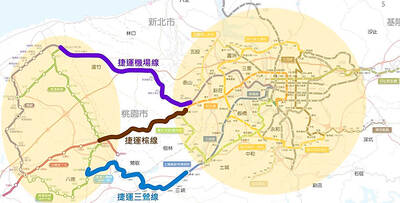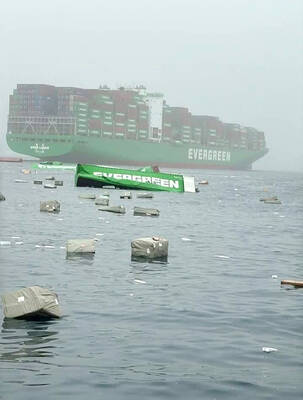The nation does not have an adequate number of buoys along the southwest coast for a tsunami warning system after two buoys were destroyed at sea, the Central Weather Bureau (CWB) said yesterday.
The US National Oceanic and Atmospheric Administration developed a monitoring system using mid-frequency buoys manufactured by Science Applications International Corp (SAIC), the bureau said, adding that Taiwan joined the US Pacific Tsunami Warning Centers’ (PTWC) observation network after it purchased a monitoring system in 2018.
If large earthquakes occur in Indonesia or the South-Pacific region, the buoy system transmits data to the PTWC and the weather bureau, CWB Seismological Center Director Chen Kuo-chang (陳國昌) said, adding that the information helps the two agencies more accurately estimate a tsunami’s impact and issue warnings accordingly.

Photo courtesy of the Central Weather Bureau
Taiwan installed a monitoring buoy off its southeast coast and another buoy off its southwest coast, Tung Chun-ci (滕春慈) of the CWB Marine Meteorology Center said.
The first buoy has functioned reliably since its installation, but the installation of the second buoy was not as successful, Tung said.
The New Ocean Researcher ship installed the second buoy in October 2018, but it stopped sending signals in January 2019, she said.

Photo courtesy of the Central Weather Bureau
The buoy was thought to have sunk or drifted from its original location after being hit by seagoing vessels, she added.
Another buoy was installed at the site in August last year, but it began making abnormal reports on March 4, Tung said, adding that the buoy still sent signals, although tracking showed that it had drifted away from the installation site.
When the buoy was located on March 13, researchers found that its steel cables had been cut and its equipment removed, rendering it ineffective.
“The buoys installed by the CWB and the National Taiwan University [NTU] Ocean Center had anti-collision lights, radar reflectors and the CWB’s name on them to alert vessels,” Teng said.
“We think it was unlikely that the buoys were destroyed by Taiwanese fishers. They might have been damaged by fishing vessels from other countries or military ships,” she said.
“As the buoys did not have a surveillance device, it would be difficult for us to determine what happened,” she added.
Yang Yiing-jang (楊穎堅), a professor at NTU’s Institute of Oceanography and team leader at the Ocean Center, said that researchers around the world have encountered similar problems.
“The problem is that tsunami buoys are very expensive, with each set costing NT$30 million [US$1 million], which is three to four times more than a meteorology buoy. We can only purchase tsunami buoys from SAIC,” he said. “If a buoy is broken, it has to be sent back to SAIC for repairs, because Taiwan does not have the technology to fix it. Reinstalling it also requires SAIC’s assistance.”
The CWB is also in a bind when it comes to choosing the proper site to install a tsunami buoy, Teng said.
“Installing a buoy farther from the coast would alert people longer before a tsunami strikes, but it would be more difficult to ensure that the buoy is intact,” Teng said. “It is easier for us to monitor the buoy if it is installed closer to the coast, but then the tsunami alert time is shorter.”
Tsunami alerts could be issued without the benefit of tsunami buoys or submarine cables, CWB Director-General Cheng Ming-dean (鄭明典) said.
“We have our own earthquake detection system that gathers information and also monitors tsunami alerts from the PTWC,” Cheng said. “Tsunami buoys or submarine cables help give people a longer alert time and enable us to gauge a tsunami’s impact more accurately before issuing warnings. We hope to open another public tender for a submarine cable project after raising the funds for it.”
The CWB has planned to install an 800km-long submarine cable from off the southern coast of Pingtung County to Luzon, Philippines, to detect tsunamis, but it has yet to secure a contractor for the project after five public tenders.

“China is preparing to invade Taiwan,” Deputy Minister of Foreign Affairs Francois Wu (吳志中) said in an exclusive interview with British media channel Sky News for a special report titled, “Is Taiwan ready for a Chinese invasion?” the Ministry of Foreign Affairs said today in a statement. The 25-minute-long special report by Helen Ann-Smith released yesterday saw Sky News travel to Penghu, Taoyuan and Taipei to discuss the possibility of a Chinese invasion and how Taiwan is preparing for an attack. The film observed emergency response drills, interviewed baseball fans at the Taipei Dome on their views of US President

ECONOMIC BENEFITS: The imports from Belize would replace those from Honduras, whose shrimp exports have dropped 67 percent since cutting ties in 2023 Maintaining ties with Taiwan has economic benefits, Ministry of Foreign Affairs officials said yesterday, citing the approval of frozen whiteleg shrimp imports from Belize by the Food and Drug Administration (FDA) as an example. The FDA on Wednesday approved the tariff-free imports from Belize after the whiteleg shrimp passed the Systematic Inspection of Imported Food, which would continue to boost mutual trade, the ministry said. Taiwan’s annual consumption of whiteleg shrimps stands at 30,000 tonnes, far exceeding domestic production, the ministry said. Taiwan used to fill the gap by importing shrimps from Honduras, but purchases slumped after Tegucigalpa severed diplomatic ties with Taiwan

The Executive Yuan yesterday approved a southwestern extension of the Sanying MRT Line from New Taipei to Bade District (八德) in Taoyuan, with a goal of starting construction by late 2026. The 4.03-kilometer extension, featuring three new stations, will run from the current terminus at Yingtao Fude Station (LB12) in New Taipei City to Dannan Station (LB14), where it will connect with Taoyuan’s Green Line, New Taipei City Metro Corp said in a statement. This extension will follow the completion of core Sanying Line, a 14.29-kilometer medium-capacity system linking Tucheng (土城), Sansia (三峽)

CARGO LOSS: About 50 containers at the stern of the ‘Ever Lunar’ cargo ship went overboard, prompting the temporary closure of the port and disrupting operations Evergreen Marine Corp, Taiwan’s largest container shipper, yesterday said that all crew members aboard the Ever Lunar (長月) were safe after dozens of containers fell overboard off the coast of Peru the previous day. The incident occurred at 9:40am on Friday as the Ever Lunar was anchored and waiting to enter the Port of Callao when it suddenly experienced severe rolling, Evergreen said in a statement. The rolling, which caused the containers to fall, might have been caused by factors including a tsunami triggered by an earthquake in Russia, poor winter sea conditions in South America or a sudden influx of waves,